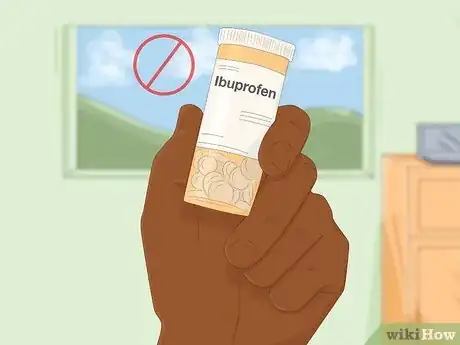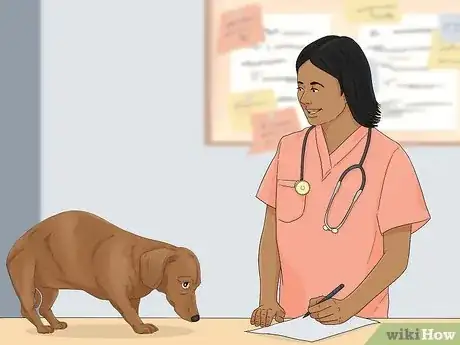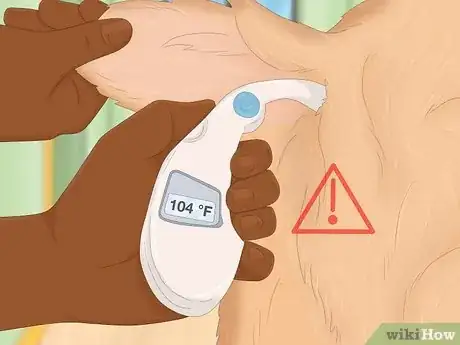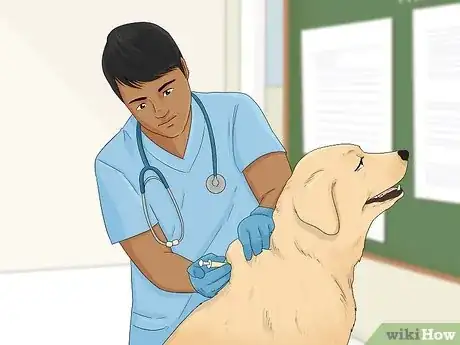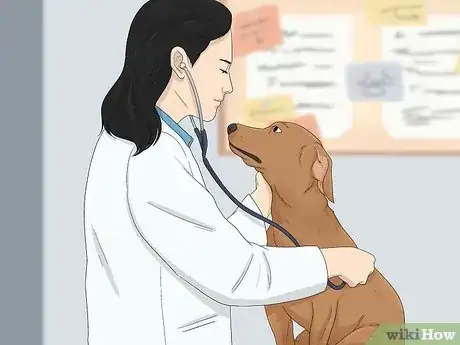This article was co-authored by Deanne Pawlisch, CVT, MA. Deanne Pawlisch is a Certified Veterinary Technician, who does corporate training for veterinary practices and has taught at the NAVTA-approved Veterinary Assistant Program at the Harper College in Illinois and in 2011 was elected to the board of the Veterinary Emergency and Critical Care Foundation. Deanne has been a Board Member of the Veterinary Emergency and Critical Care Foundation in San Antonio, Texas since 2011. She holds a BS in Anthropology from Loyola University and an MA in Anthropology from Northern Illinois University.
wikiHow marks an article as reader-approved once it receives enough positive feedback. In this case, 100% of readers who voted found the article helpful, earning it our reader-approved status.
This article has been viewed 215,883 times.
Dogs normally have a temperature between 100–102.5 °F (37.8–39.2 °C), but they can develop a fever due to an injury, infection, poisonous substance, or as a reaction to a vaccine. A fever in a dog may be 103 °F (39 °C) or higher. You may be worried about your pup when it develops a fever and wonder how you can treat it properly. See a vet as soon as possible. In the meantime, cool your dog down and keep your dog hydrated to help treat its fever. If its fever is severe or it is not getting better, bring it to the vet for treatment so it can recover fast from the fever.
Things You Should Know
- Wet a cloth with lukewarm water and wipe down your dog's ears, paws, tummy, and chest to cool their body down.
- Put fresh water in your dog’s water bowl and keep it nearby. Encourage your dog to drink often so they don't get dehydrated.
- If the fever persists, bring your dog to the vet as soon as possible. Work with your vet to treat the underlying illness or cause.
Steps
Cooling Your Dog Down
-
1Wipe your dog’s ears and paws with a tepid, wet cloth. Make sure the cloth is not cool or cold. Wipe its ear area and paws several times to help bring its body temperature down.[1]
- Make sure you also wipe your dog’s chest and abdomen to help cool it down.
-
2Give your dog a tepid bath. Check that the bath water is not ice cold, but a bit colder than lukewarm. Place your dog in the bath and use a cloth or sponge to dab water on it. Apply water to its ears, paws, chest, and abdomen.[2]
- You do not need to use soap in the bath, as you are not trying to clean your pup, just cool it down.
Advertisement -
3Dry your dog well so it does not catch a chill. After you wipe down your dog or give it a bath, make sure you dry it well so it does not get too cold. Towel dry your dog or use a hair dryer on a low setting to dry your pup.
- Wipe or bath your dog twice a day to try to bring its fever down. Make sure you dry it well each time.
Hydrating and Feeding Your Dog
-
1Make sure your dog drinks a lot of water. Put fresh water in your dog’s water bowl and encourage your dog to drink water by placing the bowl in front of it. Getting your dog to drink lots of water will ensure it does not become dehydrated due to the fever.[3]
- If your dog refuses to drink water or appears dehydrated, bring it to the vet for treatment. Dehydration, combined with a fever, can put your pup at risk of serious health issues.
-
2Give your dog its normal food. Try to get your dog to eat solid foods to help it maintain its strength. Both canned and dry foods are good for dogs with fevers. Do not try to change its food to encourage it to eat. This may give the dog gastrointestinal distress.[4]
- If your dog refuses to eat solid foods, or to eat at all, bring it to the vet for treatment.
-
3Do not give your dog human medication. Medication made to treat fever in humans, such as ibuprofen or acetaminophen, are toxic to dogs. Do not give your dog any medications without first checking with your vet.[5]
- Avoid giving your dog natural remedies, such as essential oils or herbs, without first checking with your vet.
Bringing Your Dog to the Vet
-
1Bring your dog to the vet as soon as you notice the fever. A fever can be a sign of a very serious infection and needs immediate treatment. Check to see if your dog appears very tired or sleeps more than usual. Your dog may also show no interest in eating food or drinking water. It may be sluggish and have a lack of interest in going for a walk or playing.[6]
-
2Let the vet take your dog’s temperature. Your dog’s temperature can only be measured with an ear or rectal thermometer made for animals. This is an invasive procedure and should only be done by your vet. Your vet will know how to keep your dog calm and relaxed as they take its temperature.[7]
- A dog with a temperature of 104 °F (40 °C) or higher is considered in serious medical danger and needs to be treated right away.
-
3Allow the vet to examine your dog. They may look at your dog’s tongue, ears, and eyes to see if there is any sign of infection. They may also test your dog’s urine and blood to see if it has been exposed to a toxic or poisonous substance.[8]
- The vet may ask you questions about your dog’s medical history to determine what might be causing the fever.
-
4Get prescription medication to bring down your dog’s fever. Your vet will prescribe an oral medication for your dog to help bring down its body temperature. Once the fever has gone down, your vet may recommend other treatment options, depending on your dog’s condition.
- Your vet can give you suggestions on how to get your dog to ingest the oral medication.
-
5Let the vet monitor your dog’s condition. Your vet may recommend that you leave your dog at the vet’s office for several hours or overnight so they can monitor your dog’s temperature. If your dog’s fever does not go down with the help of medication, your vet may suggest other treatment options or run more tests to determine the cause.
References
- ↑ http://www.akc.org/content/health/articles/dog-fever-and-temperature/
- ↑ https://www.vetinfo.com/dog-fever-treatment.html
- ↑ https://www.vetinfo.com/dog-fever-treatment.html
- ↑ https://animals.onehowto.com/article/how-to-lower-my-dog-s-fever-with-home-remedies-417.html
- ↑ http://www.akc.org/content/health/articles/dog-fever-and-temperature/
- ↑ https://www.vetinfo.com/dog-fever-treatment.html
- ↑ https://www.vetinfo.com/dog-fever-treatment.html
- ↑ https://www.vetinfo.com/dog-fever-treatment.html
About This Article
If your dog has a fever, you should take it to the vet as soon as possible, as this can be a sign of a serious infection or injury. In the meantime, dampen a cloth with tepid water and use it to wipe down the dog’s ears, paws, and chest to help it cool down. You can also bathe the dog in tepid water to help bring its temperature down. Afterward, dry the dog thoroughly with a soft towel to ensure it doesn’t get chilled as its temperature drops. Keep reading for advice from our Veterinary co-author on how to keep your dog hydrated and comfortable while it has a fever!





